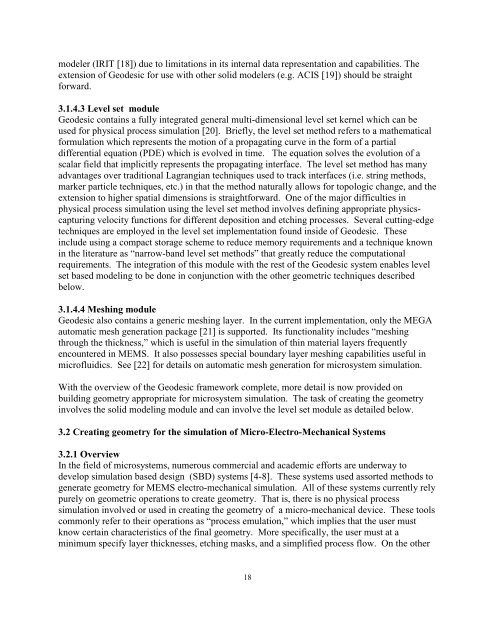Advanced CAD System for Electromagnetic MEMS Interactive Analysis
Advanced CAD System for Electromagnetic MEMS Interactive Analysis
Advanced CAD System for Electromagnetic MEMS Interactive Analysis
Create successful ePaper yourself
Turn your PDF publications into a flip-book with our unique Google optimized e-Paper software.
modeler (IRIT [18]) due to limitations in its internal data representation and capabilities. The<br />
extension of Geodesic <strong>for</strong> use with other solid modelers (e.g. ACIS [19]) should be straight<br />
<strong>for</strong>ward.<br />
3.1.4.3 Level set module<br />
Geodesic contains a fully integrated general multi-dimensional level set kernel which can be<br />
used <strong>for</strong> physical process simulation [20]. Briefly, the level set method refers to a mathematical<br />
<strong>for</strong>mulation which represents the motion of a propagating curve in the <strong>for</strong>m of a partial<br />
differential equation (PDE) which is evolved in time. The equation solves the evolution of a<br />
scalar field that implicitly represents the propagating interface. The level set method has many<br />
advantages over traditional Lagrangian techniques used to track interfaces (i.e. string methods,<br />
marker particle techniques, etc.) in that the method naturally allows <strong>for</strong> topologic change, and the<br />
extension to higher spatial dimensions is straight<strong>for</strong>ward. One of the major difficulties in<br />
physical process simulation using the level set method involves defining appropriate physicscapturing<br />
velocity functions <strong>for</strong> different deposition and etching processes. Several cutting-edge<br />
techniques are employed in the level set implementation found inside of Geodesic. These<br />
include using a compact storage scheme to reduce memory requirements and a technique known<br />
in the literature as “narrow-band level set methods” that greatly reduce the computational<br />
requirements. The integration of this module with the rest of the Geodesic system enables level<br />
set based modeling to be done in conjunction with the other geometric techniques described<br />
below.<br />
3.1.4.4 Meshing module<br />
Geodesic also contains a generic meshing layer. In the current implementation, only the MEGA<br />
automatic mesh generation package [21] is supported. Its functionality includes “meshing<br />
through the thickness,” which is useful in the simulation of thin material layers frequently<br />
encountered in <strong>MEMS</strong>. It also possesses special boundary layer meshing capabilities useful in<br />
microfluidics. See [22] <strong>for</strong> details on automatic mesh generation <strong>for</strong> microsystem simulation.<br />
With the overview of the Geodesic framework complete, more detail is now provided on<br />
building geometry appropriate <strong>for</strong> microsystem simulation. The task of creating the geometry<br />
involves the solid modeling module and can involve the level set module as detailed below.<br />
3.2 Creating geometry <strong>for</strong> the simulation of Micro-Electro-Mechanical <strong>System</strong>s<br />
3.2.1 Overview<br />
In the field of microsystems, numerous commercial and academic ef<strong>for</strong>ts are underway to<br />
develop simulation based design (SBD) systems [4-8]. These systems used assorted methods to<br />
generate geometry <strong>for</strong> <strong>MEMS</strong> electro-mechanical simulation. All of these systems currently rely<br />
purely on geometric operations to create geometry. That is, there is no physical process<br />
simulation involved or used in creating the geometry of a micro-mechanical device. These tools<br />
commonly refer to their operations as “process emulation,” which implies that the user must<br />
know certain characteristics of the final geometry. More specifically, the user must at a<br />
minimum specify layer thicknesses, etching masks, and a simplified process flow. On the other<br />
18
















